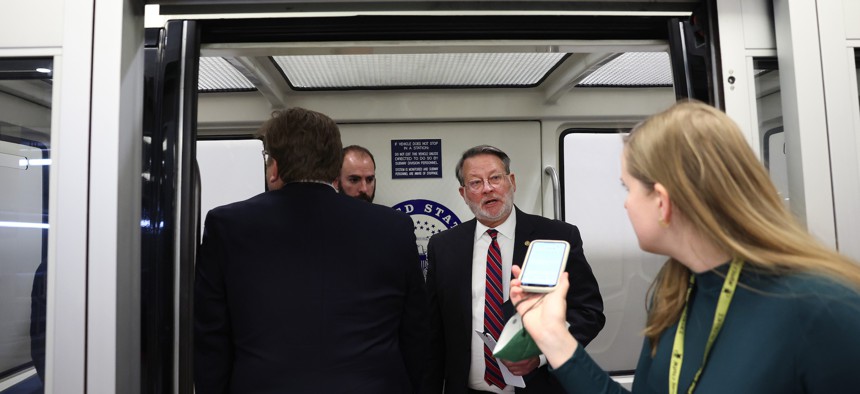Improving government capacity is key for AI deployment, experts tell Congress

Sen. Gary Peters, D-Mich., talks to a reporter on the Senate subway Kevin Dietsch/Getty Images
The chair of the Senate Homeland Security and Governmental Affairs Committee, Gary Peters, D-Mich., said he plans to zero in on procurement and AI, specifically.
Artificial intelligence capabilities could help governments at the state, local and federal level offer translation services, create chatbots and assist employees in their everyday work. But to harness that potential, governments need to invest in capacity, witnesses stressed to lawmakers during a Wednesday hearing held by the Senate Homeland Security and Governmental Affairs Committee.
The committee’s hearing on AI and customer experience follows five it held on AI last year, said the committee’s chair, Sen. Gary Peters, D-Mich., who has focused particularly on the intersection of government and AI, as well as on customer experience.
The next big focus: federal procurement and AI, a topic the committee held a hearing on last September.
“This issue is actually a major priority for this committee, and we're in the process of looking at some reforms to the procurement process,” Peters said during the hearing.
“How the federal government procures AI… is going to have a big impact on AI throughout the economy,” he told Nextgov/FCW. “And I think that's a very effective way for us to think about AI regulation, through the procurement process.”
Procurement is one of the sets of issues that witnesses, including civic tech leader and former U.S. Deputy Chief Technology Officer Jennifer Pahlka, urged lawmakers to simplify.
“The Federal Acquisition Regulation is… 2,400 pages,” said Pahlka. “Any time something has that many different provisions, you're going to have people fighting over interpretations of things…Speed and flexibility are the two things that you should be designing for if you think about any kind of procurement reform.”
Greater simplicity and streamlining will also help smaller vendors make it into the marketplace, said Beth Simone Noveck, chief innovation officer and chief AI strategist for New Jersey and professor at Northeastern University.
Mastery of the GSA schedules “should not be the sole threshold to being able to do business with the federal government,” she said.
Another sore spot witnesses urged lawmakers to pay attention to is government hiring of AI experts and training of current feds on AI.
“There's a huge relook that we have to do on who we hire and in what capacity in government,” said Pahlka. “Then, we also need to be able to hire those people.”
Government hiring is its own knot of longstanding problems — including long timelines and complicated policies — that will be critical to the implementation of the Biden administration’s executive order on AI.
Capacity-building also includes giving public sector workers simpler policy frameworks for the programs they run and “reducing burdens,” Pahlka urged lawmakers.
Several of the witnesses said sound data practices within government and open government data will also be key.
“When public institutions attempt to dive into the deep end of analytics, automation or machine learning without first building a strong data practice, they run the risk of propagating disparate impacts [and] poorly informing decisions,” said Beth Blauer, associate vice provost for public sector innovation at the Johns Hopkins University
Pahlka noted in her written testimony that, currently, government agencies often struggle to retain sufficient rights to data vis-a-vis contractors.
The promise of AI is that it can work in the background to “free up” public sector workers by taking on some of the many bureaucratic processes and allowing the workers to focus on service delivery, said Blauer, who also urged government to invest in capacity by “investing in the creation of public space to experiment with the new AI.”
“I think government can lead in the use of artificial intelligence for public good,” said Noveck. “AI has the potential to make government more effective, more efficient and more responsive to residents.”
As for what lawmakers should do, Pahlka urged them to “pair mandates and directives with enablement.
“Agencies want to do these things — they want to improve government and government service delivery. And there are many things that often stand in their way, make them take a long time to do things, jump through a lot of hoops,” she continued. “As you direct them to take these actions, also ask them what can we remove to make this easier?”






